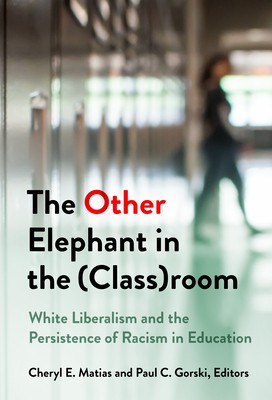
- We will send in 10–14 business days.
- Publisher: Teachers College Press
- ISBN-10: 0807768820
- ISBN-13: 9780807768822
- Format: 15.9 x 22.8 x 0.6 cm, minkšti viršeliai
- Language: English
- SAVE -10% with code: EXTRA
The Other Elephant in the (Class)Room (e-book) (used book) | bookbook.eu
Reviews
Description
Purposeful, intentional racial bias poses an obvious threat to the possibility of real equity in schools. In this volume, antiracist educators explore an equally troubling, but insufficiently explored threat: the racism upheld by schools and districts that claim an antiracist commitment. These institutions perpetuate disparities by enacting that commitment through surface-level and soft diversity and inclusion goals and popular initiatives that are more equity optics than antiracism. This book asks: How is racism perpetuated through actions, programs, practices, and initiatives that might appear to be inclusion-oriented or "progressive," but never quite get around to eliminating racism? How do these efforts pose as racial equity while protecting systems of advantage and disadvantage--creating a sort of equity inertia? The book then asks: What would antiracism look like if we enacted a deeper antiracist approach? What is a truer vision for racial equity? Diverse authors apply these questions to an equally diverse assortment of programs and practices, such as trauma-informed care, social-emotional learning, restorative practices, anti-bias work in early childhood education, Montessori schooling, "inclusive" social studies curricula, and toxic positivity and "niceness" as stand-ins for racial equity.
Book Features:
- Illustrates how K-12 educators can adopt more authentically justice-oriented approaches to antiracism.
- Draws on existing theoretical frameworks such as critical race theory, critical whiteness studies, culturally sustaining pedagogies, and equity literacy.
- Examines concepts such as white fragility, racial battle fatigue, white privilege, and interest convergence.
- Includes a range of authors, from racial justice scholars to classroom teachers.
- Offers an engaging and accessible format that combines narrative with theoretical grounding, bridging critical analysis to visions for moving forward.
EXTRA 10 % discount with code: EXTRA
The promotion ends in 21d.13:29:05
The discount code is valid when purchasing from 10 €. Discounts do not stack.
- Publisher: Teachers College Press
- ISBN-10: 0807768820
- ISBN-13: 9780807768822
- Format: 15.9 x 22.8 x 0.6 cm, minkšti viršeliai
- Language: English English
Purposeful, intentional racial bias poses an obvious threat to the possibility of real equity in schools. In this volume, antiracist educators explore an equally troubling, but insufficiently explored threat: the racism upheld by schools and districts that claim an antiracist commitment. These institutions perpetuate disparities by enacting that commitment through surface-level and soft diversity and inclusion goals and popular initiatives that are more equity optics than antiracism. This book asks: How is racism perpetuated through actions, programs, practices, and initiatives that might appear to be inclusion-oriented or "progressive," but never quite get around to eliminating racism? How do these efforts pose as racial equity while protecting systems of advantage and disadvantage--creating a sort of equity inertia? The book then asks: What would antiracism look like if we enacted a deeper antiracist approach? What is a truer vision for racial equity? Diverse authors apply these questions to an equally diverse assortment of programs and practices, such as trauma-informed care, social-emotional learning, restorative practices, anti-bias work in early childhood education, Montessori schooling, "inclusive" social studies curricula, and toxic positivity and "niceness" as stand-ins for racial equity.
Book Features:
- Illustrates how K-12 educators can adopt more authentically justice-oriented approaches to antiracism.
- Draws on existing theoretical frameworks such as critical race theory, critical whiteness studies, culturally sustaining pedagogies, and equity literacy.
- Examines concepts such as white fragility, racial battle fatigue, white privilege, and interest convergence.
- Includes a range of authors, from racial justice scholars to classroom teachers.
- Offers an engaging and accessible format that combines narrative with theoretical grounding, bridging critical analysis to visions for moving forward.


Reviews